
|
|||
|---|---|---|---|
|
|
Effort during the shotokan karate
kumite Esforço durante o kumitê do karate shotokan no 13º Campeonato Brasileiro JKA, 2012 El esfuerzo durante el kumite de karate shotokan en 13º Campeonato Brasileño JKA, 2012 |
|
|
|
Master in Science of the Human Motricity by the Castelo Branco University, RJ (Brazil) |
Nelson Kautzner Marques Junior |
|
|
|
Abstract The study objective was determined the duration of the tactical action and of the attack action and the energy metabolism during the female kumite and of the male kumite. The qualifying matches in team (total of fights: 14) was filmed during the 13th Brazilian championship of shotokan karate. In notebook, the researcher determined the time of the action during the kumite with software KinoveaTM (version 0.8.15). The scout was used to write the action that occurred in the fight. The female kumite had the following results: 8,58±8 seconds in tactical action, 2,66±1,71 seconds in attack action and 15,33±15,01 seconds in break of the fight by referee. The male kumite had the following results: 11,40±10 seconds in tactical action, 1,75±0,70 seconds in attack action and 18,68±18 seconds in break of the fight by referee. Kruskal-Wallis ANOVA noted significant difference (p≤0,05) between the duration of the efforts during the kumite, H (5) = 820,66. The Mann-Whitney U test, used as post hoc, detected significant difference (p≤0,05) in all comparisons. The female kumite versus the male kumite had the following results: female tactical action x male tactical action (U = 7,42), female attack action x male attack action (U = 2,03) and female break of the fight by referee x male break of the fight by referee (U = 6,76). Female kumite had 89% of effort aerobic and 11% in anaerobic metabolism alactic. Male kumite had 43% of effort anaerobic alactic and 57% in aerobic metabolism. In conclusion, determine the effort during the kumite is important for the coach elaborates the training. Keywords: Karate. Sport. Fight. Kumite. Effort. Energy metabolism.
|
|||
|
|
EFDeportes.com, Revista Digital. Buenos Aires, Año 17, Nº 172, Septiembre de 2012. http://www.efdeportes.com/ |
|
|
1 / 1
Introduction
The shotokan karate style was developed by the Japanese and master Gichin Funakoshi on the island of Okinawa1. Shotokan karate is a fight with punches, kicks and defenses during the competition and during the self-defense2. The kumite of the shotokan karate is a high intensity fight because the technique of offensive and defensive consists of fast action lasting few seconds3. Marques Junior4 informed that the decisive actions during the kumite occur in few seconds. The punches with higher index score are the gyaku zuki, the kizami zuki and the oi zuki5 and the kicks with most points in karate are the mae geri and the mawashi geri. These punches and kicks are performed at high speed in the fight.
The offensive techniques of the shotokan karate must be performed at high speed to result in attack point and avoid the counter attack of the opponent6. The fast action of the karate is in anaerobic metabolism alactic with intermittent activity (effort and pause) because, after the offensive technique of an karateka, the referee stops kumite and determines the point attack (ippon – perfect attack or waza-ari – efficient attack) or if there is no score in the attack7. The literature of the shotokan karate determines that during the kumite occurs the tactical action (the study of the karateka before of the attack) in aerobic metabolism and occurs the attack action (moment of the offensive karate technique) in anaerobic metabolism alactic8-10.
However, studies of the shotokan karate11-13 have not determined the difference in duration of effort during the kumite male versus the kumite female. The action of male kumite attack is faster than the female kumite? The tactical action of female kumite takes longer than the male kumite? Known these questions, the objective was to determine the duration of the tactical action and of the attack action during the female kumite and of the male kumite. The study also had the objective of determine the energy metabolism during the female kumite and of the male kumite.
Material and methods
Sample, data collection and data analysis
The qualifying matches in team (total of fights: 14, 7 female kumites and 7 male kumites) was filmed during the 13th Brazilian championship of shotokan karate JKA of 2012 (Key: JKA = Japan Karate Association). The JKA is responsible by research and teaching of the karate. The JKA is authorized by the Ministry of Education of the Japan to conduct championship. The fights were filmed by digital camera Sony® handycam, model DCR-SX20 on the tripod Mirage®. The data were collected in a gymnasium, at a distance of 2 meters and a height of 3 meters. The fights took place from 11 to 15 hours, at a temperature of 26ºC in autumn of Rio de Janeiro, capital of the state of Rio de Janeiro, Brazil. The filming occurred in the following order: female team kumite (total of fights = 3), female team kumite (total of fights = 3), female team kumite (total of fights = 1), male team kumite (total of fights = 3), male team kumite (total of fights = 3) and the male team kumite (total of fights = 1). The duration of the filming of the fights is shown in table 1.
Table 1. Duration of the filming
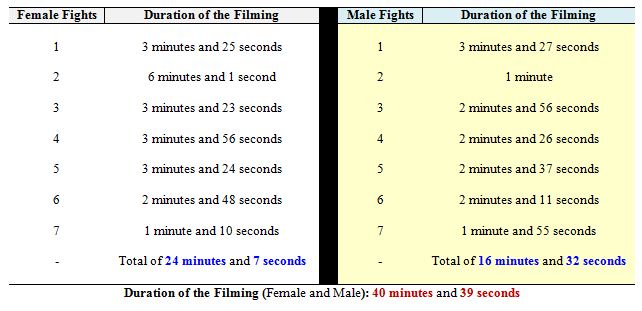
The film team kumite was copied from the camera trough the wire to the ACER® notebook, model 4320. In notebook, the researcher determined the time of the tactical action, the time of the attack action and the time of the break of the fight by referee with software KinoveaTM (version 0.8.15, www.kinovea.org/en/). Software KinoveaTM was used in the study of Silva et alii14. The scout adapted from Oslin et alii15 was used to the notes of the action occurred in the fight (velocity and duration). Tactical actions and the attack actions were classified according to the effort in the fight (velocity and time in action). Knowing the effort in kumite, the researcher determined the energy metabolism during the combat of the shotokan karate. Based in Fox et alii16, Janssen17, Marques Junior18,19, the characteristics energy metabolism is shown in table 2.
Table 2. Energy metabolism
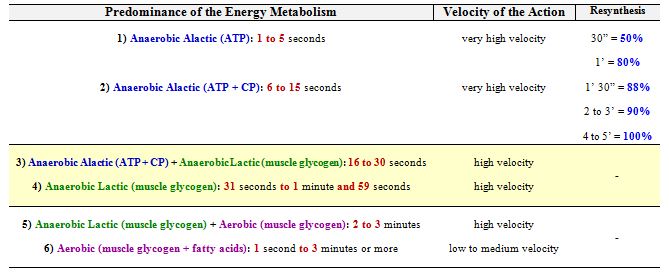
In the scout adapted from Oslin et alii15, the researcher used to annotate the velocity and time during the action in kumite. The scout is presented for the reader in table 3.
Table 3. Effort during the kumite of the shotokan karate.

Statistical Analysis
Results are expressed as means±standard deviations and percentage. The normality of data was assessed by the Shapiro Wilk test (p≤0,05). In case of data normal, the difference during the actions of the kumite were analyzed using an One-Way ANOVA with results accepted a level of significance of p≤0,05. Where a significant difference was found, a Scheffé post hoc test was used with results accepted a level of significance of p≤0,05. When the results have significant difference the research calculated the effect size (ES) in accordance with Dancey and Reidy20 (ES = [Mean – Mean]: Mean of the Standard Deviation). In case of data not normal, the difference during the actions of the kumite was analyzed using a Kruskal-Wallis ANOVA H test with results accepted a level of significance of p≤0,05. Where a significant difference was found, the Mann-Whitney U test was used as post hoc with results accepted a level of significance of p≤0,05. The results with significant difference the research calculated the effect size (ES) in accordance with Dancey and Reidy20 (ES = [Mean – Mean]: Mean of the Standard Deviation). All the figures were calculated according to the procedures of the Windows 7.
Results
Table 4 presents the mean and the standard deviation of the effort during the female kumite and of the male kumite.
Table 4. Effort in seconds during the kumite team

Shapiro Wilk test determined data not normal. Kruskal-Wallis ANOVA verified significant difference (p≤0,05) between the duration of the efforts during the kumite, H (5) = 820,66. The table 5 shows the results of the Mann-Whitney U test.
Table 5. Results of the difference between the duration of the efforts in seconds during the kumite team.
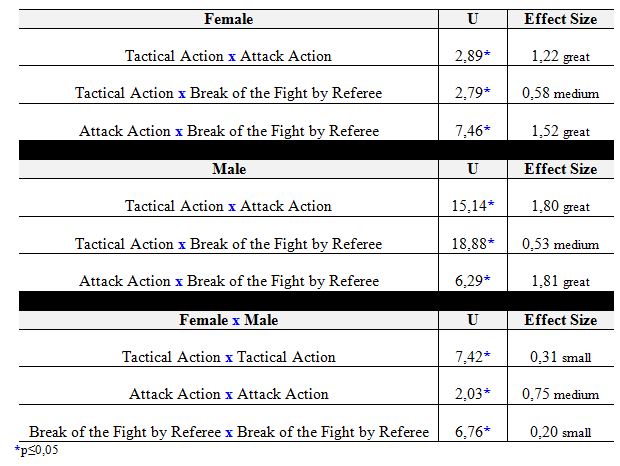
The Figure 1 illustrates the mean and the standard deviations of the efforts in seconds during the kumite team.
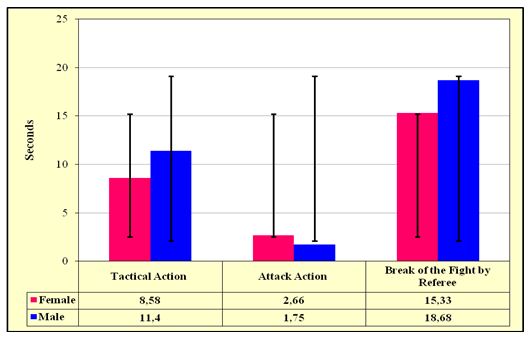
Figure 1. Type of effort during the kumite team
Female fight of the shotokan karate had 89% of effort aerobic (41% of tactical action and 48% of break of the fight by referee) because the karateka practiced with low to medium velocity during the kumite. But the attack action the female karateka practiced with high velocity and in a few seconds, 11% in anaerobic metabolism alactic. The seconds are presented in percentage, see figure 2.
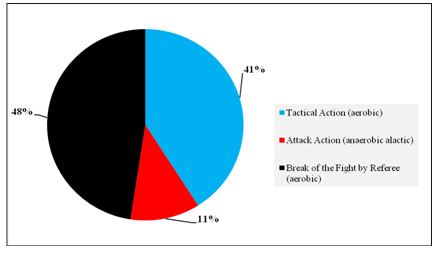
Figure 2. Effort of the female team kumite
Male fight of the shotokan karate had 43% of effort anaerobic alactic (37% of tactical action and 6% of attack action) because the karateka practiced with high velocity and in a few seconds the actions during the fight. The pause of the male karateka occurred during the break of the fight by referee, 57% in aerobic metabolism. The seconds are presented in percentage, see figure 3.
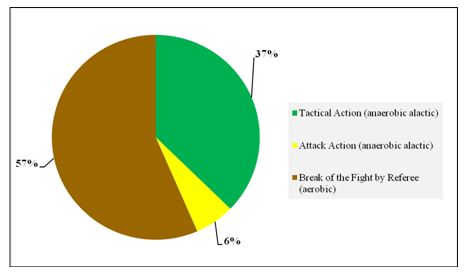
Figure 3. Effort of the male team kumite
Discussion
The kumite of the shotokan karate JKA has duration from 1 minute and 30 seconds to 2 minutes. The attack action of the female kumite (2,66±1,71 seconds) and of the male kumite (1,75±0,70 seconds) occurred in high velocity and the alactic anaerobic metabolism predominated. The result of this study is in accordance with the literature of the karate21. The study by the Mann-Whitney U test detected significant difference (p≤0,05) in attack action, male kumite had the attack action faster than the female kumite. The references of karate22,23 do not determine the difference in seconds of the attack action of the female kumite versus the male kumite.
The tactical action of the female kumite occurred from low to medium velocity and the aerobic metabolism predominated during 8,58±8 seconds. The result of the female kumite during the tactical action is in accordance with the literature of the shotokan karate8. However, the tactical action of the male kumite occurred at high velocity and the anaerobic metabolism alactic was the predominant during 11,40±10 seconds. By adding the times (measured in seconds) of the tactical action (11 seconds) with the attack action (~ 2 seconds) was obtained 13 seconds in anaerobic metabolism alactic. The male kumite took place at high intensity. This is in accordance with Maughan et alii24.
The high intensity of the male kumite (tactical action and attack action) and small period of recovery in aerobic metabolism (break of the fight by referee of 18,68±18 seconds) causes a resynthesis insufficient of the anaerobic metabolism alactic. The literature about recovery of the ATP-CP (adenosine triphosphate and creatine phosphate) during the sprint training determined a pause from 30 seconds to 5 minutes25,26. The relation between the anaerobic alactic effort (E) and the aerobic pause (P) of the male kumite was of 1:1 (E: P, 13 seconds of effort: ~ 19 seconds of pause). Probably the male karateka used the anaerobic metabolism lactic because he practiced an incomplete resynthesis of the ATP-CP. Roschel et alii3 suggested that during the male kumite occurred some contribution of the anaerobic metabolism lactic. Others studies confirmed that male kumite had some contribution of the anaerobic metabolism lactic27,28.
The relation between the anaerobic alactic effort (E) and the aerobic pause (P) during the female kumite was of 1:8. The duration of the attack action during the female kumite approached 3 seconds. The pause of the female kumite occurred with an active phase (tactical action of ~ 9 seconds) and a passive phase (break of the fight by referee of 15 seconds) in aerobic metabolism (Aerobic Metabolism = 9 seconds + 15 seconds = 24 seconds). Effort and pause (1:8, 3 seconds of effort: 24 seconds of active and passive pause) of the female kumite resulted in resysnthesis of the ATP-CP because the anaerobic alactic phase was small and the active and passive pause lasted the next 30 seconds (30 = 50% of resynthesis of the ATP-CP). Some studies determined that the pause duration between 15 to 20 seconds causes resysnthesis of the ATP-CP wich optimizes the performance of the athlete during the anaerobic alactic training29,30.
The study had a limitation, a scout was used to determine the anaerobic phase and the aerobic phase during the female kumite and the male kumite. However, this study may be only research on the duration in seconds of the three moments of the female kumite and of the male kumite (tactical action, attack action and break of the fight by referee).
Conclusion
In female kumite and in male kumite, the study demonstrated that attack action occurs in a few seconds, at high velocity and during the anaerobic metabolism alactic. The tactical action of the male kumite occurred in anaerobic metabolism alactic. The relation between effort and pause of the female kumite was of 1:8 and of the male kumite was of 1:1.
The predominance in anaerobic metabolism alactic (1 to 15 seconds) during the training of the karateka is important for the session has the same energy metabolism of the karate fight. Session in anaerobic metabolism alactic has 1 to 10 repetitions and 2 to 5 sets. The pause for the female karateka needs of passive rest (break of the fight by referee) and/or active rest (tactical action) lasting from 24 seconds (≅ 30% of resynthesis of the ATP-CP) to 4 minutes (100% of resynthesis of the ATP-CP) for occur the resynthesis of the ATP-CP. But the pause for the male karateka needs of passive rest (break of the fight by referee) during 10 or 19 seconds to 4 minutes for result in complete resynthesis of ATP-CP or incomplete. The incomplete resynthesis of ATP-CP during the training causes in next stimulus a work in the anaerobic metabolism lactic.
Forteza31 recommended the relation effort and pause for prescription of the metabolic training, can be used in shotokan karate: anaerobic alactic with 1:3 or 1:2, anaerobic lactic with 1:2 or 1:1 and aerobic metabolism with 1:½ or 1:1.
In conclusion, determine the effort during the kumite is important for the coach elaborates the training.
References
-
Frosi T, Mazo J (2011). Repensando a história do karatê contada no Brasil. Rev Bras Educ Fís Esporte 25(2):297-312.
-
Katic R et alii (2009). The impact of specific motricity on karate performance in young karateka. Coll Antropol 33(1):123-130.
-
Roschel H et alii (2009). Associations between neuromuscular tests and kumite performance on the Brazilian Karate National Team. J Sports Sci Med 8(3):20-24.
-
Marques Junior N (2011). Karatê shotokan: biomecânica dos golpes do karatê de competição. Lecturas: Educ Fís Deportes 16(158):1-7. http://www.efdeportes.com/efd158/karate-biomecanica-dos-golpes-do-kumite.htm
-
Marques Junior N (2011). Karatê shotokan: pontos dos golpes durante o kumitê de competição masculino. Ulbra Mov 2(1):1-15.
-
Marques Junior N (2011). Sugestão do mawashi geri do karatê shotokan com embasamento da biomecânica. Rev Movimento 4(1):66-72.
-
Beneke R et alii (2004). Energetics of karate kumite. Eur J Appl Physiol 92(-):518-523.
-
Arriaza R (2009). Karate. In. Kordi R et alii (Eds.). Combat sports medicine. Berlin: Springer, 2009. p. 287-297.
-
Francescato M et alii (1995). Energy cost and energy sources in karate. Eur J Appl Physiol 71(4):355-361.
-
Ravier G et alii (2009). Impressive anaerobic adaptation in elite karate athletes due to few intensive intermittent sessions added to regular karate training. Scand J of Med Sci Sport 19(-): 687-94.
-
Doder D, Doder R (2006). Effect of anthropological characteristics on the efficiency of execution of forward kick. Procedings for Natural Sciences, Matica Srpska -(110):45-54.
-
El-Daly A (2010). Biokinematical analysis for “mai-mawashi geri” based on two different levels of the competitor`s body in karate. World J Sport Sci 3(3):161-167.
-
Fernandes F et alii (2011). Biomechanical methods applied in martial arts studies. J Morphol Sci 28(3):141-4.
-
Silva J et alii (2011). Time-motion analysis in muay-thai and kick-boxing amateur matches. J Hum Sport Exerc 6(3):490-496.
-
Oslin et alii (1998) The game performance assessment instrument (GPAI): development and preliminary validation. J Teach Phys Educ 17(-):231-243.
-
Fox E et alii (1988). The physiological basis of physical education and athletics. 4th edition. Philadelphia: Saunders Company, 1988.
-
Janssen P (2001). Lactate threshold training. Champaign: Human Kinetics. p. 1-24.
-
Marques Junior N (2001). Metabolismo energético no trabalho muscular do treino competitivo ou do fitness. Rev Mineira Educ Fís 9(1):63-73.
-
Marques Junior N (2012). Jump test with ball for young female soccer player. Lecturas: Educ Fís Deportes, 2012; 15(166):1-7. http://www.efdeportes.com/efd166/teste-de-salto-com-bola-para-futebol.htm
-
Dancey C, Reidy J (2004). Statistics without maths for psychology. 3th edition. Harlow: Pearson.
-
Iide K et alii (2008). Physiological responses of simulated karate sparring matches in young men and boys. J Strength Cond Res 22(3):839-844.
-
Imamura H et alii (2003). Oxygen uptake, heart rate, and blood lactate responses during 1,000 punches and kicks in female collegiate karate practitioners. J Physiol Anthropol 22(2):111-114.
-
Pesic S et alii (2012). Exercise induced changes in redox status of elite karate athletes. Chinese J Physiol 55(-).
-
Maughan R et alii (1997). Biochemistry of exercise and training. New York: Oxford University, 1997.
-
Spencer M et alii (2008). Performance and metabolism in repeated sprint exercise: effect of recovery intensity. Eur J Appl Physiol 103(5):545-552.
-
Toubekis A et alii (2008). Influence of different rest intervals during active or passive recovery on repeated sprint swimming performance. Eur J Appl Physiol 93(5-6):694-700.
-
Milanez V et alii (2011). Avaliação e comparação das respostas da percepção subjetiva de esforço e concentração de lactato em uma competição oficial de karate. Rev Educ Fís/UEM 22(1):57-64.
-
Rosa W et alii (2007). Análise da cinética de lactato durante uma aula de karate-dô shotokan. Rev Bras Prescrição Fisiol Exerc 1(6):39-44.
-
Billaut F et alii (2003). Maximal intermittent cycling exercise: effect of recovery duration and gender. J Appl Physiol 95(-):1632-1637.
-
Read M, Cisar C (2001). The influence of varied rest interval lengths on depth jump performance. J Strength Cond Res 15(3):279-283.
-
Forteza A (1997). Entrenar para ganar. Madrid: Pila Telena, 1997.
Another articles in English
 |

Búsqueda personalizada
|
|---|---|
|
EFDeportes.com, Revista
Digital · Año 17 · N° 172 | Buenos Aires,
Septiembre de 2012 |
|